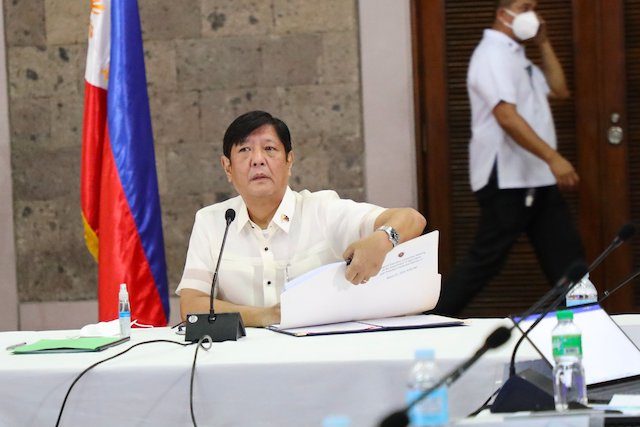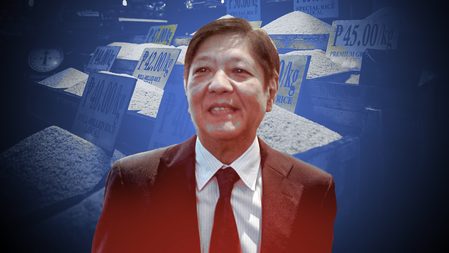SUMMARY
This is AI generated summarization, which may have errors. For context, always refer to the full article.

MANILA, Philippines – A man who promised to lower the price of rice to P20 per kilogram held his first meeting as concurrent secretary of the Department of Agriculture on July 4, the first Monday of the second Marcos administration.

President Ferdinand Marcos Jr. arrived at the Bureau of Soils and Water Management (BSWM) in Quezon City on Monday morning to meet with the department’s employees and officials who, for the first time, will have the country’s Chief Executive as their department head.
Later that day, he held his first executive committee meeting with the officials and visited the Office of the Secretary at the DA’s main office, not far from the BSWM.
Marcos brought with him top Palace officials – Executive Secretary Vic Rodriguez and Presidential Management Staff Secretary Naida Angping – indicating an aim to harmonize inner workings and policies in the agriculture department with the workflows and staff work of Malacañang where Marcos holds office.
True enough, during the meeting, he asked agriculture officials to send him drafts of executive orders they need and even spoke of asking Congress for a supplemental budget for the department.
“Tingnan natin kung may makuha pa tayo (Let’s see if we can still get some more),” he said in a video released by the Palace.
Food security and high cost of food were identified by Marcos as the most pressing problems he wanted to address as agriculture chief.
“We have to attend to the impending food crisis that it seems it will be visiting us in the next two quarters. When we look around the world, everyone is preparing for it. We are already at disadvantageous position in terms of food supply,” he told the room.
“Even with the problem of pork and chicken, we have to think very hard that people have sufficient food, number one, at the price they can afford,” he added.
One conclusion reached by the group, said Marcos, was the need to increase production of staple crops and commodities, in particular rice and corn.
He appeared to welcome one recommendation from former president Rodrigo Duterte’s agriculture secretary, William Dar, to implement programs to increase per hectare rice production, which Dar named Masagana 150 and Masagana 200, inspired by the controversial rice program of Marcos’ own father, the deposed president Ferdinand E. Marcos.
“Masagana 150, Masagana 200, these are good plans that we have to put into place, let’s operationalize them already,” he said.
In an interview with Rappler, Dar had explained the two programs. Masagana 150 would set a target of 7.5 metric tons of inbred rice production per hectare, almost double the current 4.5 MT average yield. Masagana 200 sets a target, this time for hybrid rice, of 10 tons per hectare.
Masagana 99, meanwhile, was a program implemented by the older Marcos in the 1970s which aimed to double rice harvests using a higher-yielding rice variety. It succeeded briefly but was stopped after an unsustainable credit access program left rural banks bankrupt and smallholder farmers in debt.
More vague was Marcos’ directive to “increase protection of rice and corn.” The four-minute video of the meeting released to the public was just a portion of the meeting and did not include remarks made by other officials.
It was unclear if Marcos was pertaining to trade-related protection measures, especially in light of how liberalizing trade in agricultural commodities has hurt Filipino farmers whose crops are not as competitively priced as imported options.
Marcos took up one trade-related issue during the meeting: the possible ratification of the Regional Comprehensive Economic Partnership (RCEP).
RCEP is a free trade agreement between Southeast Asian countries like the Philippines and Australia, China, Japan, New Zealand, and South Korea.
The President asked for a “short memo” on the “pros and cons” of ratifying the trade deal that would further open up the Philippine economy to imported goods but could also mean greater access of Philippine goods to markets abroad.
Looking ahead
Apart from addressing immediate concerns, Marcos also spoke of long-term initiatives like crafting a “multi-year plan” to reconstruct value chains of agricultural commodities.
“We have to reconstruct our value chain starting from our scientists, researchers, all the way to the Kadiwa store. We have to remake that model. We have a good model that was from the previous administration. It’s a very different world out there, the technology is different,” said Marcos.
Kadiwa stores are a DA initiative in which local governments set up such stores that give fishers and farmers direct access to consumers. Local governments were given grants to set up the stores in strategic locations.
The Kadiwa store concept was first implemented during his father’s presidency, primarily to address high prices of agricultural commodities. It was resurrected during the Estrada administration, then again in 2019 under Duterte.
While Marcos said the DA should not shy away from crafting plans up to year 2030 because six years may not be enough, he pedaled back to give assurances that “we can do this in less than six years.”
DA officials present at the meeting included Undersecretary of Attached Agencies Rodolfo Vicerra; National Food Authority Administrator Judy Carol Dansal; Undersecretary for Regulations Zamzamin Ampatuan; Undersecretary for Research, Innovation, Training, and Extension Support Leocadio Sebastian; Undersecretary for Consumer and Political Affairs Kristine Evangelista; and some assistant secretaries.
Production and prices
“Agriculture is going to be a critical and fundamental part of our economic transformation,” said Marcos in his inaugural address last Thursday, June 30, setting high expectations that the neglected sector would finally get the attention and budgetary support it needs under the new president.
But for Marcos to truly make a dent on the lives of Filipinos through his work with the department, he will have to set his eyes on a literal gut issue for citizens: the soaring cost of food.
One major driver of more expensive food is the surge in oil prices triggered by the Russia-Ukraine war. More expensive petroleum means higher cost of fertilizer used by farmers to produce essential crops like rice and corn. This has a domino effect on other food because corn is used as feeds for livestock and poultry so when they get expensive, pork and chicken get pricier too.
“The biggest and most urgent challenge facing President/Secretary Bongbong Marcos in the agriculture sector is how to bring consumer food costs to levels similar to consumers in neighboring countries, while enabling farmers to increase productivity so as to be competitive with farmers in, say, Thailand or Vietnam,” Bruce Tolentino, an economist who sits as a member of the Bangko Sentral ng Pilipinas’ Monetary Board, told Rappler.
Tolentino had also been deputy director general at the International Rice Research Institute from 2012 to 2018.
Solutions floated by economists include giving out fertilizer subsidies to farmers, something done by the previous administration. Some economists, however, also look at additional measures that only a President can implement: further slashing or removing altogether tariffs and non-tariff barriers on imported corn, pork, chicken, and similar goods.
But such moves would have to be accompanied by funds aimed at helping Filipino farmers harvest more and earn more, said Tolentino.
One such effort to liberalize agricultural trade, the rice tariffication law, is another concern of Marcos. On Monday, he said he wants a “reassessment” of the law and the Rice Competitiveness Enhancement Fund it created for farmers.
The law is really due for a periodic evaluation. Lawmakers have expressed openness to amending it, after outcry from farmers’ groups. Former agriculture secretary Dar had also said he would wait for the evaluation before passing judgment on whether the law should be repealed, amended, or retained.
Another way to increase production of farmers, said Dar then, was to widen the coverage of irrigation systems since rice and many other crops are dependent on water. With the National Irrigation Administration’s poor performance spanning multiple administrations, he suggested tapping the private sector for big-ticket irrigation works. – Rappler.com
Add a comment
How does this make you feel?

![[In This Economy] Marcos’ POGO ban is popular, but will it work?](https://www.rappler.com/tachyon/2024/07/thought-leaders-marcos-pogo-ban.jpg?resize=257%2C257&crop=255px%2C0px%2C720px%2C720px)
![[Rappler Investigates] POGOs no-go as Typhoon Carina exits](https://www.rappler.com/tachyon/2024/07/newsletter-graphics-carina-pogo.jpg?resize=257%2C257&crop=424px%2C0px%2C1080px%2C1080px)





![[Just Saying] SONA 2024: Some disturbing points](https://www.rappler.com/tachyon/2024/07/TL-marcos-sona-points-july-23-2024.jpg?resize=257%2C257&crop=335px%2C0px%2C720px%2C720px)






There are no comments yet. Add your comment to start the conversation.